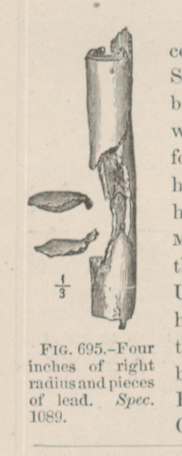Title: S. T. Wilfong
Source text: The Medical and Surgical History of the War of the Rebellion. (1861-65.), Part 2, Volume 2 (Washington, DC: Government Printing Office, 1876), 954.
Civil War Washington ID: med.d2e30901
TEI/XML: med.d2e30901.xml
CASE 1910.—Sergeant S. T. Wilfong, Co. A, 12th North Carolina, aged 19 years, was wounded at Chancellorsville, May 3, 1863, and entered Lincoln Hospital, Washington, one week afterward. Acting Assistant Surgeon H. M. Dean reported: "Compound comminuted fracture of right radius in its middle third by a minié ball. May 11th, resected some four inches of the shaft of the radius. In the operation the interosseous artery was wounded high up, and, owing to the close proximity of the elbow joint, could not be got at to tie. The forceps was therefore left on it to control the hæmorrhage, which it did very effectually. 15th, a large abscess has formed, which, although opened freely, is connected by a sinus from the wrist to the elbow. 17th, had hæmorrhage from the wound about noon; forceps still in the wound. 18th, had hæmorrhage at four o'clock P. M., and again at five and a half o'clock P. M., which was very persistent. Amputation of the arm in the lower third was agreed upon, and performed the same afternoon, by antero-posterior skin flaps, by Surgeon H. Bryant, U. S. V. 19th, patient is feeling quite comfortable. 21st, still continues to do well; appetite very good. 26th, has had no bad symptoms since the operation. June 1st, still continues to recover." The excised portion of the radius is represented in the adjacent wood-cut (FIG. 695), two flattened pieces of lead, as though a distorted ball and a buckshot, being mounted with the specimen. The specimen was contributed by Assistant Surgeon H. Allen, U. S. A. Surgeon G. S. Palmer, U. S. V., recorded that "the patient was transferred to the Old Capitol Prison June 25, 1863."
